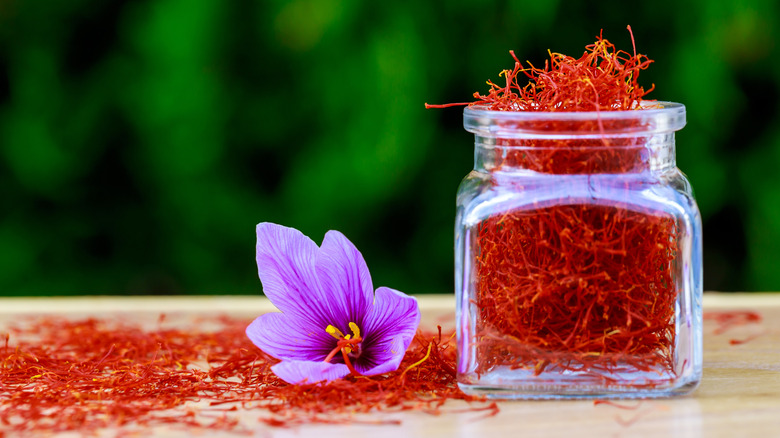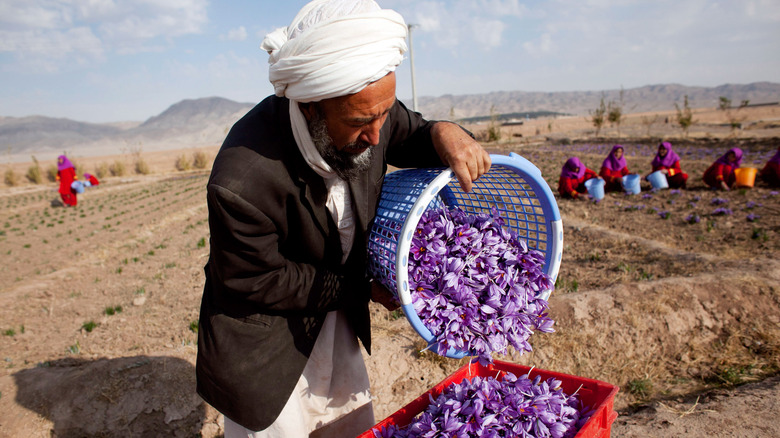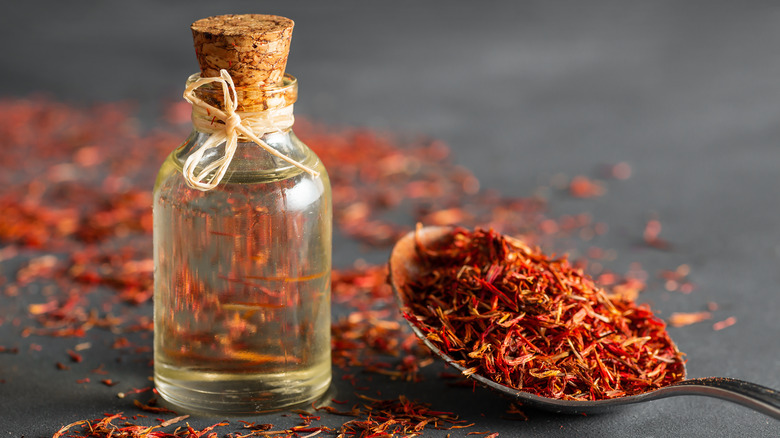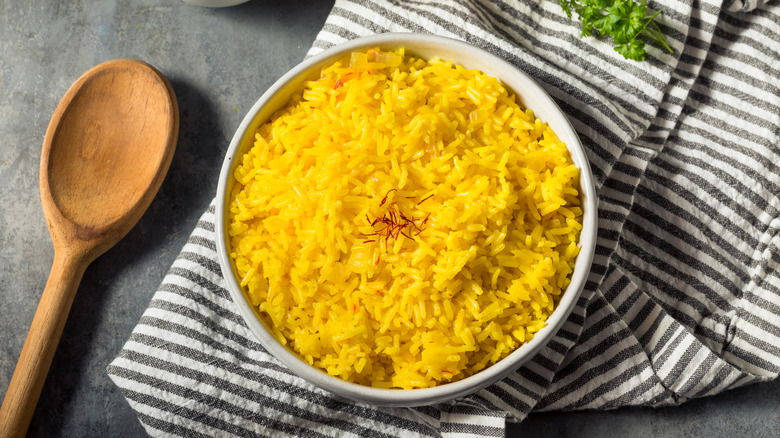Most Of The World's Saffron Comes From This Country
In a world of spices, we all have our favorites: cumin, garlic, oregano, cracked black pepper, nutmeg, cinnamon, the works! The demand for spices worldwide is never ceasing, but with climate change affecting consistent harvests and the rise of spice used in health products and household kitchens, the spice industry is facing new production challenges (via British Broadcasting Company).
According to Financial Express, spices like cumin, coriander, black pepper, and dry chili have had their prices increase exponentially over the last year because of ongoing supply issues paired with never-ending demand. As spice prices continue to climb, one of the most valuable and delicious has become notable for its sheer expense.
Saffron is the stuff of legends and may even seem magical to those who've never gotten the chance to use it before. It isn't hard to find on the market, but boy is it pricey. Bon Appétit breaks saffron down simply enough: It is a spice harvested from the crocus sativus flower, appears in bright red threads, and is known for its ability to dye things vibrant red, orange, and yellow hues. It is truly a one-of-a-kind plant and incredible when used in recipes.
Saffron in Iran
Saffron most likely isn't as stockpiled in your pantry as other spices like chili pepper or cardamom, but for many people in Southwest Asia, saffron is an essential part of culinary and economic life, especially in Iran. According to Statista, Iran — which lies in the heart of the Middle East — is by far the leading producer of saffron. In 2019, the country grew 430 tons of the highly coveted spice, with its market competitor — India — harvesting only 22 tons. Eating Well says that the spice thrives in hot, dry climates like that of Spain, Afghanistan, and India, but it is Iran that successfully produces 90% of the world's total saffron.
To give you an even better idea of how Iran dominates the global saffron market, the Financial Tribune reports that Iran has been cultivating this spice for over 3,000 years for medical, culinary, and cosmetics purposes. 80% of Iran's total production is exported to over 65 countries, and Iran's saffron industry employs over 200,000 people annually. The country dedicates over 115,000 hectares of land to saffron production, and that area is expected to continue to expand over the coming years.
The history of saffron
Iran loves its saffron aka red gold or "Zafaran" as the Persians call it (via Friendly Iran). The spice has played an important role in Persian cuisine for centuries and the bright color of the spice is widely used to dye the wool and yarn used for Iranian carpets and rugs. But despite its heavy importance in the lives of Persian culture, saffron is an expensive luxury spice. For an ounce of red saffron to be made, 7,000 purple saffron must be harvested by hand.
For those of you who are unfamiliar with the spice, saffron has a strong aroma and floral taste which has been widely used for color and flavor in Mediterranean and Asian rice dishes for centuries (via Britannica). According to Sativus, it is believed that the people of the East Mediterranean have been cultivating saffron since 2300 B.C. There is a detailed record of the spice being used in historic literature such as the Bible, several famous Greek, Roman, and Iranian poems, and Kashmiri Tantric Hindu epics. There is no doubt that this spice was considered a valuable and treasured aspect in the lives of our ancestors and at times, it was considered worth more than gold.
What are the uses of saffron?
As the most expensive spice in the world, real saffron can be priced as high as $10,000 per kilogram (2.2 pounds), via Insider. This is because of how labor-intensive the growing and harvesting process is and that the flower itself can't grow in the wild, per National Geographic. Despite its steep price, the spice is prized for its health benefits, culinary aspect, and even in skincare. Forbes reports that saffron is known for its calmative, antidepressant, and anti-inflammatory properties when consumed.
Healthline goes on to say that the spice is a powerful antioxidant, and has been used to treat depressive and premenstrual syndrome symptoms. Food Network recommends adding this spice to your diet by incorporating it into your culinary practices like in Indian, Moroccan, and Iranian cuisine. Saffron brings a bright yellow and crimson color and an earthy-sweet flavor to dishes such as curries, chicken tagine, tahdig, paella, orzo, risotto, and bouillabaisse.
If you don't feel like adding saffron to your diet, how about your skincare routine? Women's Health Magazine states that saffron-based products are fantastic for your hair, skin, and acne and have been used to enhance people's looks since the ancient Indian medical system, Ayurveda, was created. Basically, saffron is going to be beneficial no matter which way you use it.



